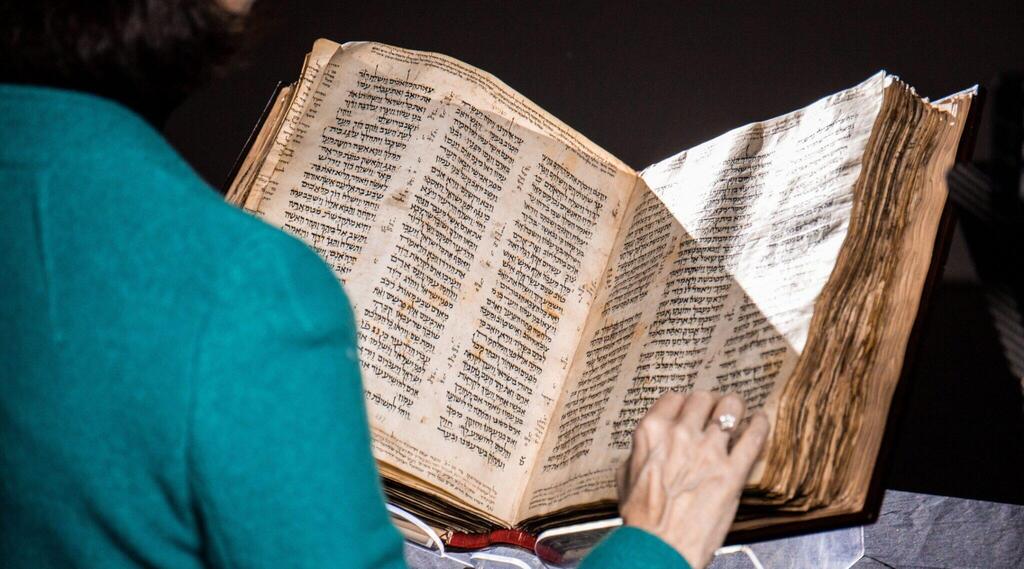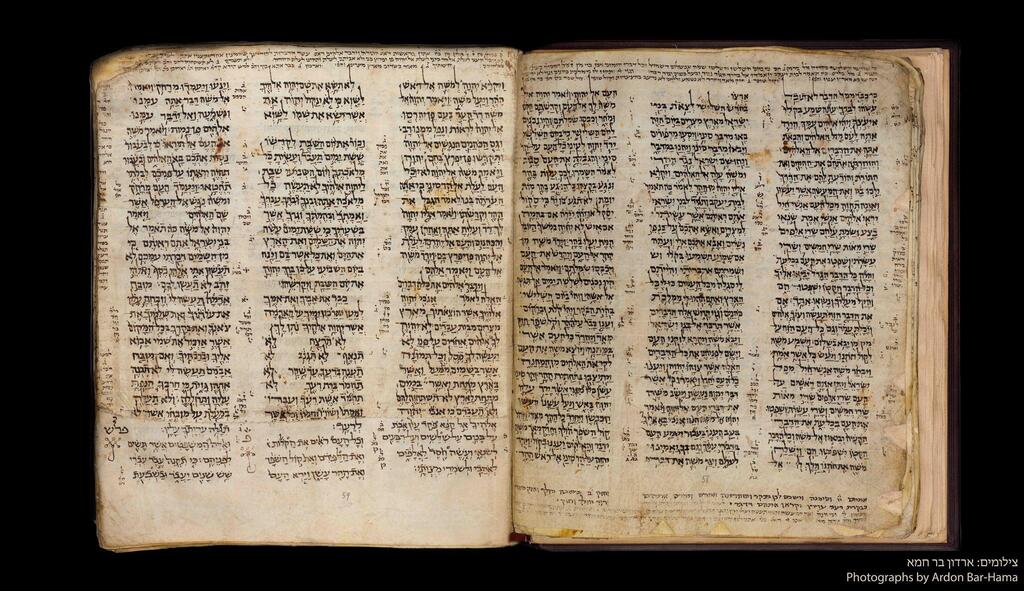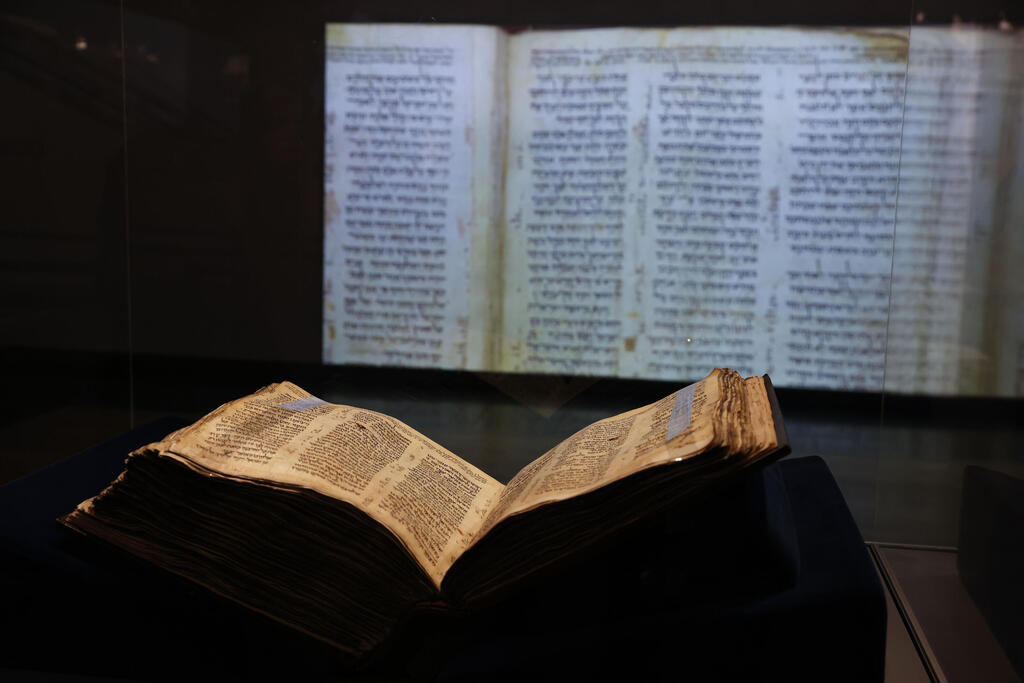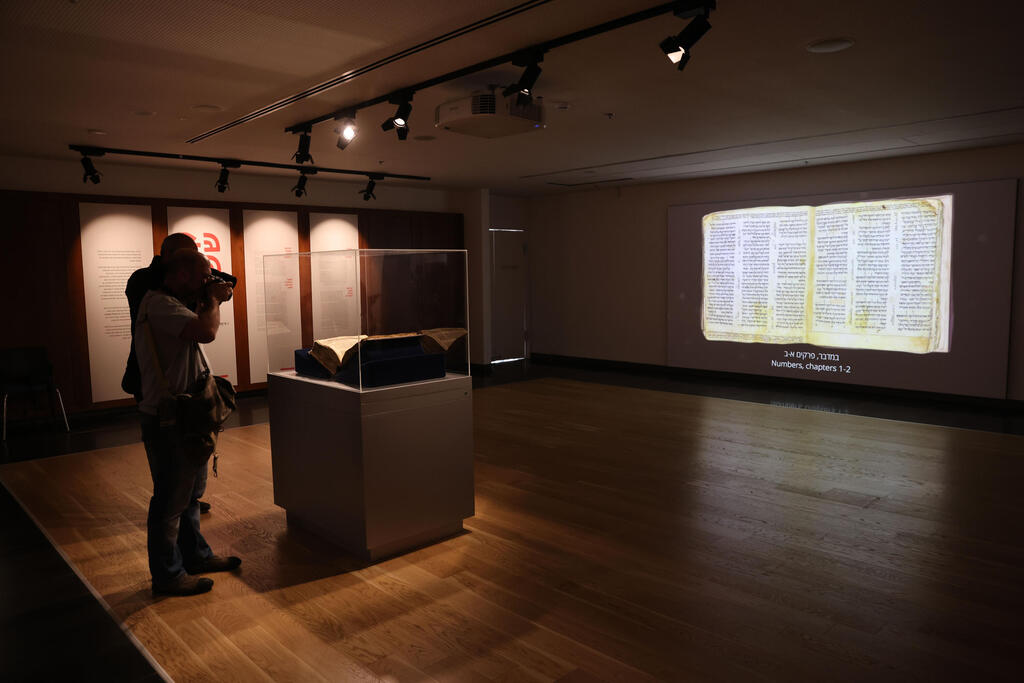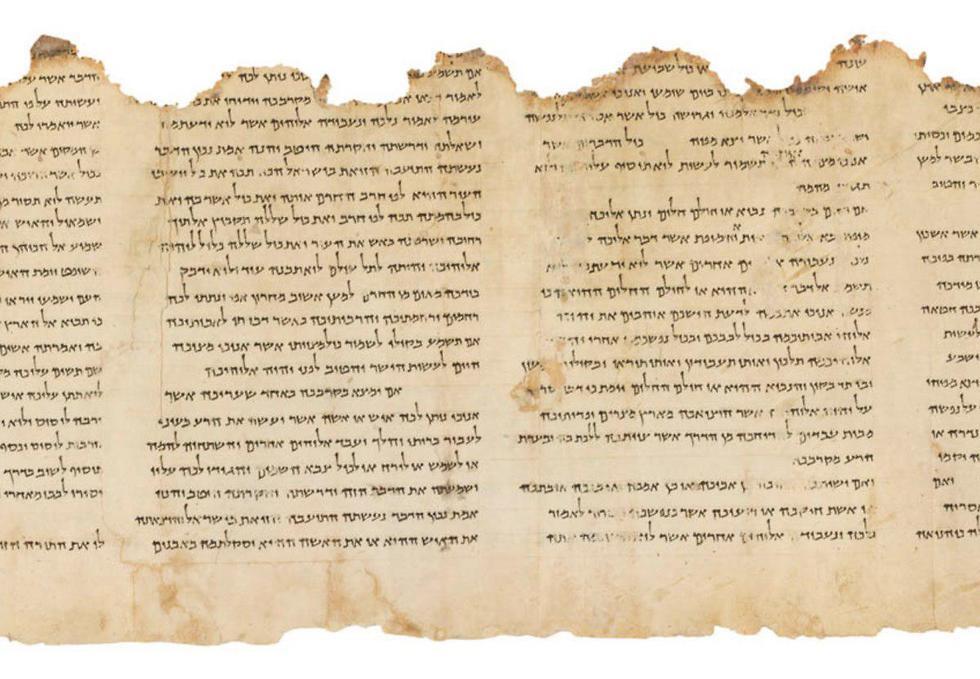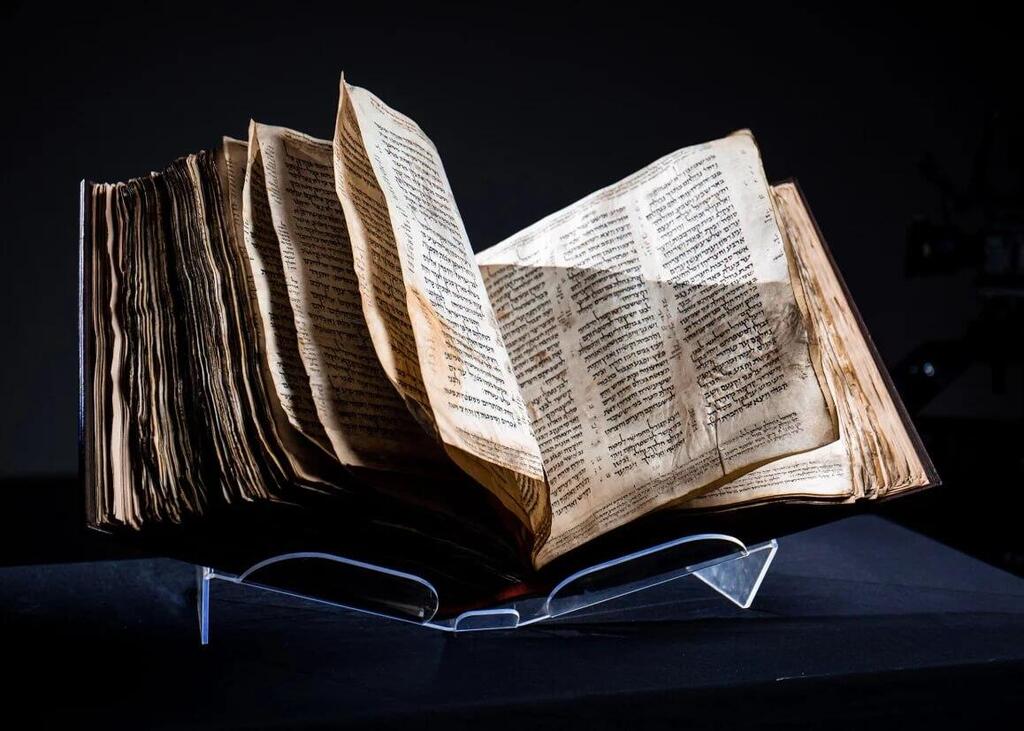Getting your Trinity Audio player ready...
Codex Sassoon, world's oldest complete copy of the Bible, arrives in Israel
(Video: marabu.pr)
After wandering for thousands of years, much of which hidden from the public eye, the Codex Sassoon, the oldest complete copy of the Bible, returned home and landed in Israel Thursday morning and will be displayed to the public next week at ANU - Museum of the Jewish People in Tel Aviv.
Read more:
When the moment of truth arrived, the Codex Sassoon was placed into a secure crate, and it was loaded onto the plane, accompanied by museum personnel and security.
A special film was screened during the flight, explaining to the passengers about the special guest that had joined the journey – an announcement that received numerous rounds of applause from the passengers. Watch it above.
"It's very moving; it's essentially coming full circle because after so many years, this book is arriving in the Eretz Israel. It's like the ingathering of the exiles of the people of Israel," said El Al First Officer Raffi Tal who joined the flight. "It’s hard to prepare for this; on the other hand, when it surprises you, it’s the most fun. I knew about it only a few hours before I left the country."
Dozens of people welcomed the ancient Bible at Ben Gurion Airport, as well as Yom Kippur War hero Avigdor Kahalani, U-19 and U-20 national soccer team coach Ofir Haim and singer Shuli Rand. From there, it was transported in a secure convoy to the museum, where it will be cared for and prepared for the moment of truth next week - the exhibition at the ANU Museum.
The purchase of the ancient Bible, which broke the record as the most expensive ancient book ever sold on an auction, has rekindled interest in the tome that for thousands of years was a closely guarded secret. Almost 800 parchment pages bound together, on which the books of the Bible are handwritten, almost as we know them today. To understand how unique and exceptional this item is, one must follow the various twists and turns it has undergone.
The Codex Sassoon’s journey to the Land of Israel
The Codex Sassoon was written in the late 9th-early 10th century in the Muslim realm of that era, which extended across the region of southern Syria. Above and below the verses appear notes written by Masoretes, scholars of textual transmission. These notes explain how to copy the Bible accurately, indicating where verses begin and providing instructions on correct vowel pronunciations.
Over the years, the ancient Bible passed from hand to hand, each transfer documented in its bookplate, including repeated warnings that those who sell the book will be cursed.
In the 12th century, the book was gifted to a synagogue in the city of Maxin, present-day Mezze, in northern Syria. For decades, the Bible was preserved in the synagogue of the Jewish community in the city. Not much is known about that community, but estimates suggest it was a Jewish community that was expelled from the Land of Israel by the Assyrian empire.
The last testimony found in the ancient Bible dates back to the early 14th century when it was gifted to Salman ibn Abi al-Fakhir, "until the synagogue is rebuilt" in Maxin. It is believed that the synagogue, and probably the entire community, were wiped out during a raid by Mongolian tribes in the Middle East.
From the 14th century until 1929, the Codex Sassoon disappeared from the face of the earth. That year, a man from Ankara contacted Aharon Freiman, who oversaw Baron Edmond de Rothschild's manuscript collection, and offered to purchase this ancient Bible.
Rothschild decided not to buy the book, but suggested to his friend David Sassoon to acquire the precious treasure. Sassoon purchased the book for almost half of the asking price - about 380,000 pounds. He referred to a senior researcher who determined that the book was probably written around 1100 AD.
9 View gallery
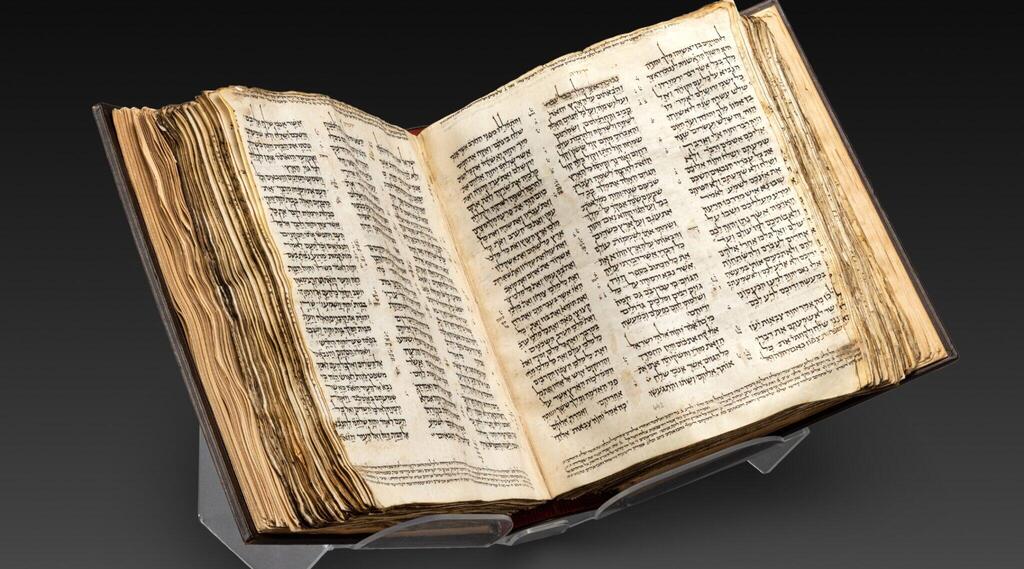

The Codex Sassoon is the oldest, most complete link between the ancient oral tradition and the modern rabbinic tradition
(Photo: Sotheby's)
Years passed and Sassoon's children sold the Codex, along with other manuscripts, to the British Railway Workers' Pension Fund. The fund brought the book for safekeeping in the British National Library - and in 1982 it was displayed to the public for a short time. Since then, Codex Sassoon has remained underground for decades, like a guarded secret.
During this time, it changed hands again, underwent brief research, and a carbon test verified that the book was written at the end of the ninth or the beginning of the tenth century, which earned it the title of the oldest complete copy of the Bible in the world. Last year, the book once again arrived at Sotheby's auction house – and here begins the short journey of the Sassoon Codex to its permanent home in Israel.
‘As if it was supposed to be here all along’
When the Sassoon Codex arrived at Sotheby's for the second time, Dr. Sharon Liberman Mintz, a senior advisor at the auction house, received it, and the excitement was evident.
"The Jewish people have many treasures, some of which we had the opportunity to sell. But for the Hamburg Talmud, for example, there were another 11 copies, and there were more prayer books – but there is only one nearly complete ancient Hebrew Bible. That's what made everyone so impressed, and its presence is also very impressive," Liberman-Mintz explained.
The auction house went on a display tour with the Sassoon Codex, contacting the Anu Museum which ultimately led to the Bible’s arrival in Israel. "One evening, my friend Sharon from Sotheby's called me and asked if I wanted to display the oldest Bible in history," ANU Chief Curator Dr. Orit Shaham-Gover recounts.
"I had no inkling of what this Bible was, and I started asking people what they knew about it. On the first day, everyone told me 'they’re pulling your leg, no one has heard about it,'" Shaham-Gover shares. "They told me to ask for Sassoon's catalog number, she sent it to me – and everyone who said they were playing me had to eat their hat."
The Sassoon Codex was displayed at the heart of the museum's Bible exhibition for a week, and the public arrived in droves. "Everyone came to see it. You can't say there's a particular gender, sector, age or hat that was more interested than others in coming to see the Codex," Shaham-Gover recounted.
"It's so moving to see something that is eleven hundred years old, and we recognize the punctuation, and even my grandchildren can read and understand what is written. There's something very mystical about it."
The fact that everyone could read the verses written in the ancient Bible also represented a kind of closure for Irina Nevzlin, the chair of the museum’s board of directors.
"I grew up in a home where it was forbidden to acknowledge that you are Jewish. Until age 13, I had never seen any Bible or Torah scroll. When I saw a Bible for the first time, it was at age 13, in a Jewish school, and I couldn't read Hebrew. Now, when I come here, in front of the Sassoon Codex, I can read 'Hear, O Israel,'" the Soviet-born entrepreneur and writer says.
When it arrived for a week at the museum, something very strange happened, something inexplicable. When it was placed in our exhibition – it was as if it was supposed to be there all along, right in the exhibition about the Bible and its influence," Nevzlin recounts. "That same week, one of the donors, Alfred Moses, called me and said it belongs to the museum and must return to Israel."
The competition was not easy for ANU, and they faced off against other private collectors, museums and libraries – but ultimately they won the public auction and broke quite a few records along the way. The Sassoon Codex was purchased by former U.S. Ambassador to Russia Alfred Moses for about $38 million, a record sum for a Jewish manuscript, and for any ancient book in the world.
"The fear was that if we did not win, we would lose not only as a museum but as a country, and we would not bring it home," Nevzlin says. "It's an honor to be part of a historical process. It's genuinely a historical process to bring the oldest Bible home. It's an opportunity that we all received. How many people get such a chance to be part of something so historical? I feel a mission on behalf of the people and for the State of Israel."
9 View gallery
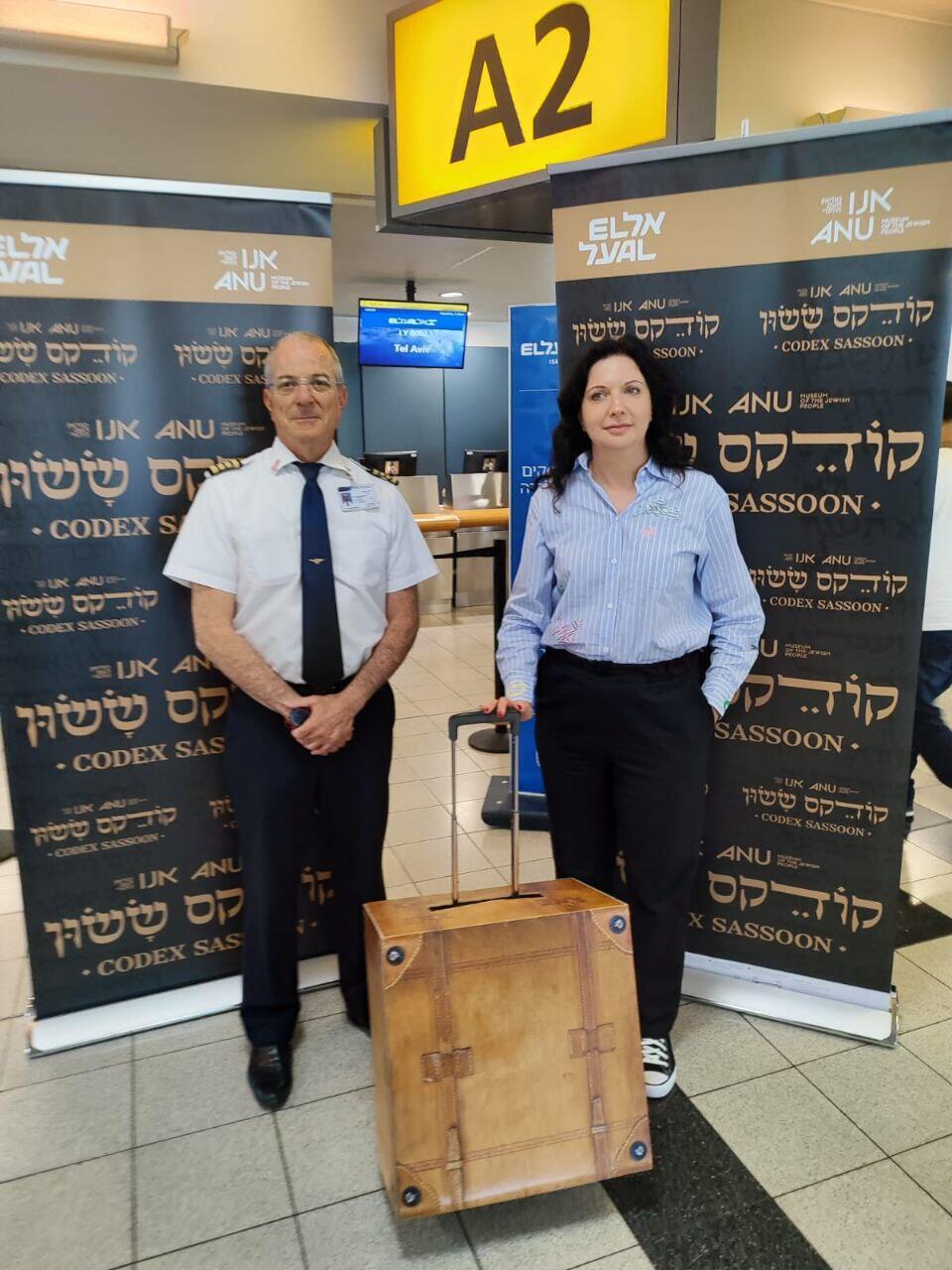

El Al pilot Amos Aldag and ANU Museum Chair Irina Nevzlin with the Codex Sassoon
(Photo: marabou.pr)
After months of intensive work, involving preparations by the auction house, the museum and El Al airline, which flew the Bible on a special flight, the Sassoon Codex landed in Israel on Thursday, finally returning home.
The Mona Lisa of the Jewish world
In addition to the powerful impact that the Sassoon Codex has on its viewers, prompting it to be named the "Mona Lisa of the Jewish world" in the museum, there is a wealth of knowledge to be gained from the world's oldest Bible. Dr. Shaham-Gover describes that the book inherently reflects the development of the Hebrew language and script.
She adds, “The Dead Sea Scrolls (the earliest copy of Jewish scripture not in book form) are written without separation or vocalization. But in the centuries since the Hebrew language fell out of everyday use, and then when Jewish scholars awakened and devised the vocalization, the Sassoon Codex is among the first of its kind, it is the first vocalized Bible. It's so fundamental that it's not merely vocalized; there are also notes on the vocalization to guide scribes in avoiding errors.”
It should be noted that this is not the final version of the Bible; the order of the books is not as it appears in the Bibles printed today. In order to preserve the copying format, the scholars of the tradition wrote notes and instructions for other scribes copying the Bible.
The Codex Sassoon contains notes from scholars of two different generations. The first scribe, likely from around the year 1000, wrote his notes below, while the second, about 150 years later, erased the notes of the first scholar and wrote his comments above the verses.
Looking at the sale deeds that appear in its bookplate teaches about the reflection of the ecolution of Jewish culture, and the transitions it underwent in relation to its environment. For instance, the first sale deeds in the book are in Hebrew, but those from the medieval period are written in Judeo-Arabic – a local dialect of Arabic using Hebrew letters, much like Yiddish.
The Codex Sassoon embodies many secrets and mysteries – for which no answer has been found. Starting from the blood-red dots that appear on some of the pages, to the question of the source from which the Bible was copied. "We are certainly aware that it is a copy – since we have a source in the Dead Sea Scrolls, but we don't know who copied it," said Shaham-Gover.
"We know that one person copied the entire book, based on the ink and writing style. We also know that in order to produce such an item at the end of the ninth century, one had to be very wealthy – after all, it requires slaughtering 200 sheep, and processing their skins, to produce 796 parchment pages of a book of this kind. It was a very expensive process," one expert explains.
On top of that, another mystery shrouds the document which has not been answered to this day – what happened to the Codex Sassoon between the 14th century and 1929. "We don't know who the person was that offered Aharon Freiman the Codex Sassoon, only that the money was transferred to Turkey," said Dr. Liberman-Mintz. "Freiman kept records, but he fled from Germany during the Holocaust and the records disappeared."
‘Putting things into perspective’
The book arrived Thursday on a special El Al flight from New York to Israel, where it will be kept in a secure and protected complex for several days – and by next week it will already be situated in its permanent display at the ANU Museum of the Jewish People.
At a time when Israel is grappling with an endless rift between various sectors of society, ANU staff hope that the Bible will provide the nation with some inspiration and peace at these daring times.
"We need to learn from the Codex that our people have a glorious history. The ninth century means a lot, and the Bible not only survived but is also intact. It could put into perspective the crises we are going through. Here is something eternal. For me, personally, it puts things into perspective," a spokesperson for the museum says.
For Israel's Ambassador to the UN Gilad Erdan, who came to bid farewell to the Bible at a special event in New York, the ancient book is still relevant today.
9 View gallery
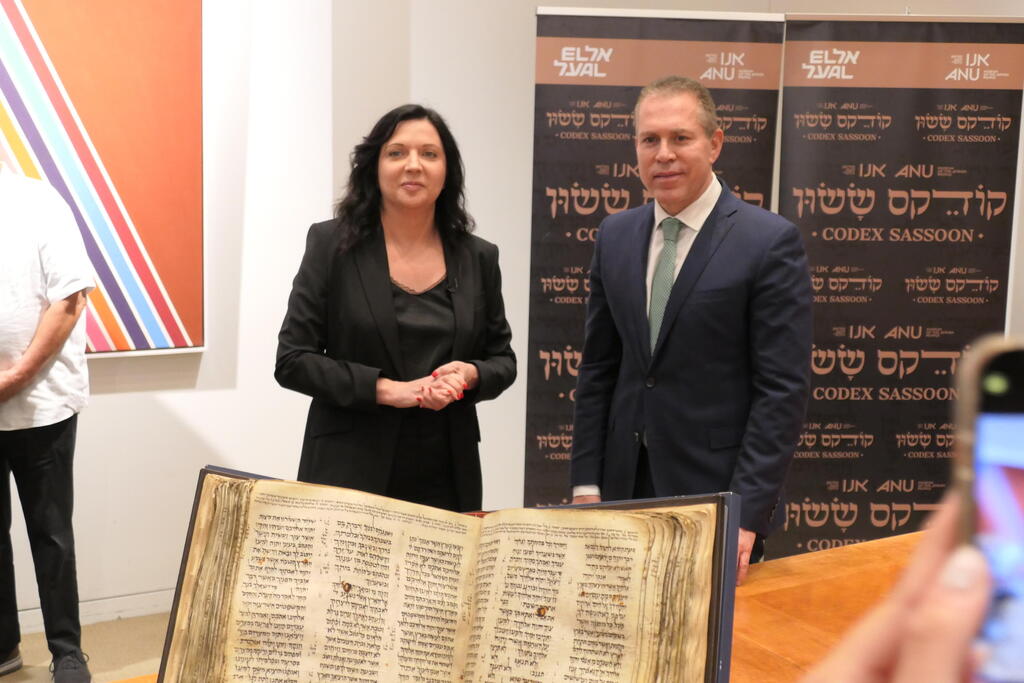

Nevzlin and Israeli Ambassador to the UN Gilad Erdan with the Codex Sassoon
(Photo: marabou.pr)
"Bringing the ancient Bible to Israel has special international significance. This ancient Bible, the Codex Sasson, is the best proof against the lies. All the truth about our history and our connection to Israel and Jerusalem is in it. The Jewish people returned to their homeland, and now this book of truth is returning to its land."
Among the people who came to say goodbye to the book at an event organized by ANU at Sotheby's auction house in New York was also a representative from the United Arab Emirates, Ahmed Obaid Al Mansoori, who has dedicated a section of his Dubai museum to the history of Zionism and the Holocaust. "For us, in the Middle East, I think religion connects us together and we have many things in common," he told attendees.
- The writer was a guest of Irina Nevzlin and the Nadav Foundation.





